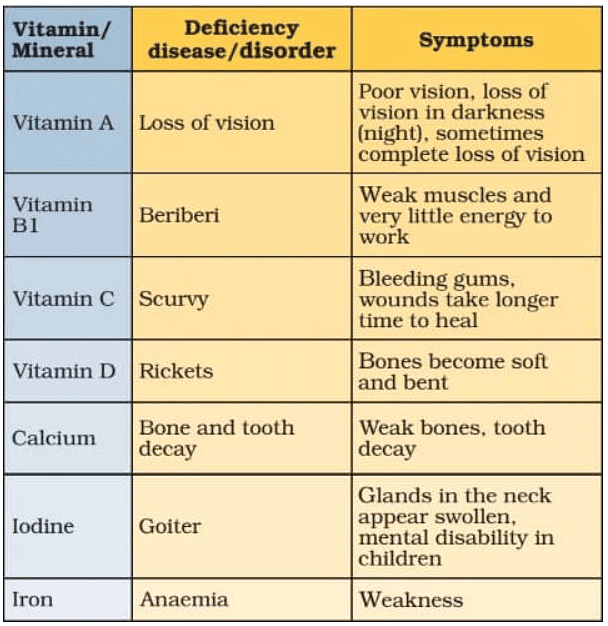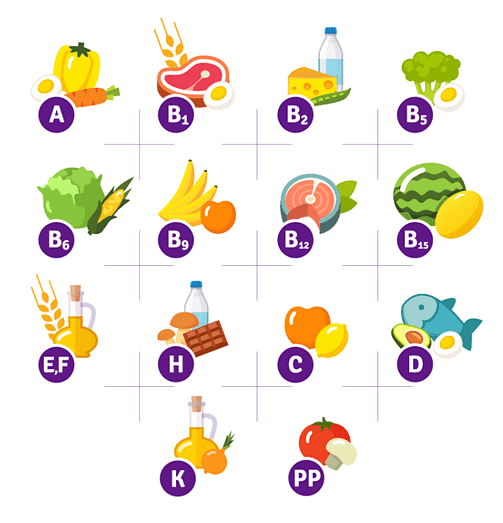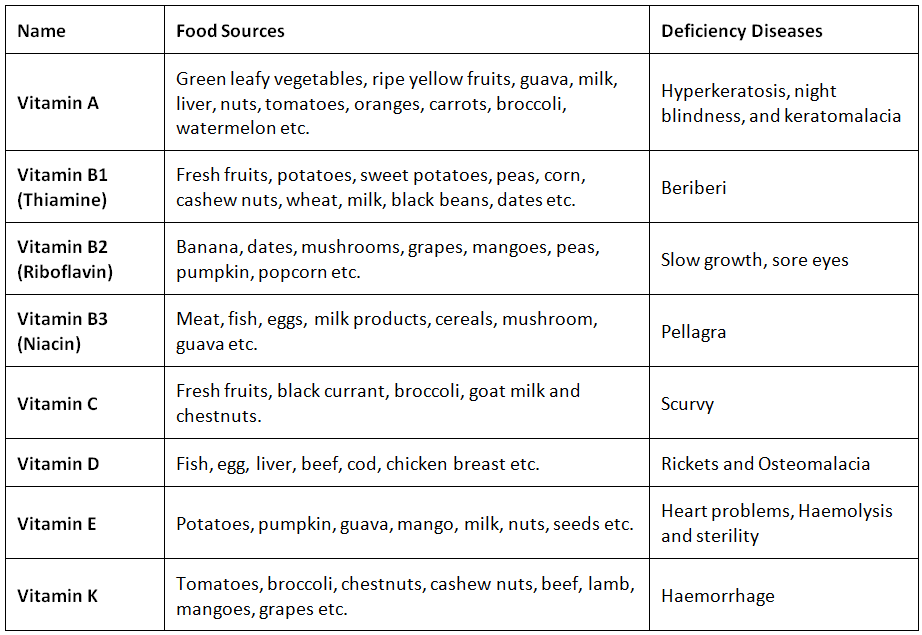Vitamins and Minerals (Deficiency Diseases) | Science & Technology for UPSC CSE PDF Download
| Table of contents |

|
| Introduction |

|
| Vitamins |

|
| Deficiency Diseases |

|
| Minerals |

|
| Five Important Micronutrients |

|
| Food Sources of Vitamins and Minerals |

|
Introduction
- Vitamins and minerals are essential nutrients that play crucial roles in maintaining good health. There are a total of 13 essential vitamins and numerous minerals that the body requires for optimal functioning.
- Both vitamins and minerals have diverse functions within the body, and consuming a well-balanced diet is the primary way to ensure an adequate intake of these nutrients.
- Here are some key differences between vitamins and minerals:
- Composition: Vitamins are organic compounds, which means they contain carbon atoms in their structure and can be broken down by heat, air, or acid. On the other hand, minerals are inorganic and maintain their chemical structure.
- Stability: Vitamins are relatively less stable and can be easily destroyed by factors like heat and air. Minerals are more stable and less susceptible to degradation.
- Some important functions of specific vitamins include:
- Vitamin A: Essential for maintaining healthy eyes, skin, and mucous membranes. It also plays a role in immune function.
- Vitamin D: Promotes calcium absorption and is crucial for maintaining strong bones and teeth.
- Vitamin K: Necessary for proper blood clotting and bone health.
- Vitamin E: Acts as an antioxidant, protecting cells from damage caused by free radicals.
- Vitamins and minerals work together to support various bodily functions, and a balanced diet that includes a variety of nutrient-rich foods is key to ensuring you meet your daily requirements for these essential micronutrients.
Vitamins
Vitamins are essential organic compounds that the body requires in small amounts for various biological functions, and their deficiency can lead to specific diseases.
Here are some key points about vitamins:
- Dietary Requirement: Most vitamins cannot be synthesized by the body and must be obtained through the diet. Plants can synthesize almost all vitamins, making them essential food components. Some vitamins can also be produced by gut bacteria.
- Classification: Vitamins are classified into various groups based on their chemical properties and functions. They are designated by letters such as A, B, C, D, etc., and some have subgroups like B1, B2, B6, B12, etc.
- Functions: Each vitamin has specific biological functions that contribute to the normal maintenance of growth and overall health. For example, vitamin A supports skin and eye health, vitamin C boosts the immune system, vitamin D aids in calcium utilization for bone health, and vitamin B12 is crucial for blood formation and nerve function.
- Excess and Supplementation: While vitamins are essential, excess intake can be harmful. Taking vitamin supplements should be done under the guidance of a healthcare professional, as excessive intake can lead to toxicity.
- Origin of the Term: The term "vitamin" was originally coined from "vital" and "amine" because early-identified compounds had amino groups. However, it was later discovered that not all vitamins contain amino groups, so the "e" was dropped from the term.
- Classification by Solubility: Vitamins are classified into two groups based on their solubility in water or fat:
- Fat-Soluble Vitamins: Vitamins A, D, E, and K are soluble in fats and oils but insoluble in water. They are stored in the liver and fat tissues and often require carrier proteins for transport in the body.
- Water-Soluble Vitamins: B-group vitamins and vitamin C are soluble in water and must be regularly supplied through the diet because they are not stored in the body (except for vitamin B12). They are readily excreted in urine.
Maintaining a balanced diet that includes a variety of nutrient-rich foods is essential to ensure an adequate intake of vitamins and minerals for overall health and well-being.
Deficiency Diseases
- A person may be getting enough food to eat, but sometimes the food may not contain a particular nutrient. If this continues over a long period of time, the person may suffer from its deficiency.
- Deficiency of one or more nutrients can cause diseases or disorders in our body. Diseases that occur due to lack of nutrients over a long period are called deficiency diseases.
- Vitamin A——— Night blindness
- Vitamin B1———Beriberi
- Vitamin B2——– Ariboflavinosis
- Vitamin B3 ——–Pellagra
- Vitamin B5 ——–Paresthesia
- Vitamin B6 ——–Anemia
- Vitamin B7 —— Dermatitis, enteritis
- Vitamin B9 & Vitamin B12 —– Megaloblastic anemia
- Vitamin C —— Scurvy, Swelling of Gums
- Vitamin D —— Rickets & Osteomalacia
- Vitamin E —— Less Fertility
- Vitamin K —— Non-Clotting of Blood.

Minerals
- Minerals are inorganic nutrients that are essential for maintaining health and well-being. They play various crucial roles in the body's normal functioning. Here are some key points about minerals:
- Inorganic Nutrients: Unlike vitamins, minerals are inorganic compounds. They are not synthesized by living organisms and are obtained through dietary sources.
- Types of Minerals: Minerals can be categorized into two groups:
- Macroelements: These are minerals required by the body in relatively large quantities. They include calcium, magnesium, potassium, and sodium. These minerals are essential for various physiological processes such as bone health, nerve function, and fluid balance.
- Trace Elements: Trace elements are minerals that are needed in very small amounts but are still essential for proper bodily functions. Some examples of trace elements include copper, iodine, iron, manganese, selenium, and zinc. They play roles in processes like enzyme function, thyroid health, and antioxidant defense.
- Specific Roles: Each mineral has specific roles and functions in the body. For example, calcium is vital for strong bones and teeth, magnesium is important for bone structure and numerous metabolic processes, potassium is involved in maintaining heart health and nerve function, and iron is essential for carrying oxygen in the blood.
- Deficiency and Health Issues: Insufficient intake of certain minerals can lead to health problems. For instance, a lack of iron can result in anemia, while inadequate calcium intake may lead to weakened bones. Proper nutrition is essential to prevent mineral deficiencies.
- Magnesium: Magnesium is particularly noteworthy for its role in bone and teeth structure. Low magnesium intake and blood levels have been associated with several health conditions, including type 2 diabetes, metabolic syndrome, heart disease, and osteoporosis.
- Food Sources: Minerals are found in various foods, and a balanced diet that includes a variety of nutrient-rich foods is crucial to ensure an adequate intake of these essential nutrients.
Overall, minerals are vital components of a healthy diet, and their presence in the right amounts is essential for proper bodily functions and overall well-being.
Five Important Micronutrients
- Nutrients are the compounds in food that provide us with energy that facilitates repair and growth and helps to carry out different life processes
- As with vitamins, minerals they are found in small quantities within the body, and they are obtained from a wide variety of foods.
- No single food contains all of the vitamins and minerals we need and, therefore, a balanced and varied diet is necessary for an adequate intake.
- Of course, we already know a huge amount about how these work, and the importance they have in normal human growth and development.
Based on this, an Expert Panel of nutritionist, NGOs, and development agencies identified five micronutrients such as those below in their priority group:
- Vitamin A: Vitamin A is essential for various bodily functions, including vision, reproduction, growth, and a healthy immune system. It plays a key role in the development of white blood cells. Good dietary sources of vitamin A include carrots, spinach, broccoli, milk, eggs, liver, and fish. A deficiency in vitamin A can lead to xerophthalmia, a severe eye disorder that can cause blindness, especially in children. Worldwide, millions of children under the age of five are at risk of vitamin A deficiency.
- Folate (Folic Acid): Folate is a group of B vitamins that includes folic acid. These vitamins are important for amino acid metabolism, protein production, nucleic acid synthesis (which carries genetic information in cells), and blood cell formation. Good sources of folate include eggs, dairy products, asparagus, orange juice, dark green leafy vegetables, beans, and brown bread. Folic acid is a synthetic folate compound often used in supplements and fortified foods due to its stability. Folate deficiency can lead to various health issues.
- Iodine: Iodine is crucial for brain development, especially in fetuses. It is essential for hormone production and various other bodily functions. While iodine-rich sources include seaweed and fish, many countries add iodine to salt as a way to ensure an adequate intake. Severe iodine deficiency can result in goiter, a visible enlargement of the thyroid gland.
- Iron: Iron is vital for transporting oxygen from the lungs to body tissues through hemoglobin, a protein found in red blood cells. It also plays a role in enzymatic reactions in the body. Iron deficiency can lead to iron-deficiency anemia, a common condition where the blood lacks enough healthy red blood cells to carry oxygen effectively. Iron-rich foods include red meat, poultry, fish, lentils, leafy vegetables, and chickpeas. Iron deficiency is a widespread health problem, particularly affecting infants in the developing world.
- Zinc: Zinc is found in various foods, such as liver, eggs, nuts, cereals, and seafood. Zinc deficiency can result in short stature, anemia, impaired wound healing, poor gonadal function, and cognitive and motor function impairments. It can also lead to appetite disorders and increase the severity and incidence of diarrhea and pneumonia. Zinc deficiency is particularly concerning for children as it can reduce their resistance to infectious diseases, contributing to the risk, recurrence, and severity of infections, including diarrhea.
These micronutrients are essential for normal growth, development, and overall health, and their deficiencies can lead to various health problems. A balanced diet that includes a variety of foods can help ensure an adequate intake of these important nutrients.
Food Sources of Vitamins and Minerals



|
90 videos|491 docs|209 tests
|















